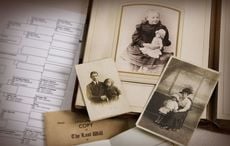The long history of Irish immigration to the United States is mixed. In 1928, two of my grandmother's brothers left Ireland for America. They never returned.
The elder was Tommy, 19, and the younger Edward, 16. He was known as Eddie and signed himself Ned. They were Mulligans, my mother's uncles. Their full names were Thomas Patrick Aloysius and Edward Mulligan, of Moyne, County Longford.
In the weeks or months before their departure, some family tension appears to have developed, and emotions climaxed one evening at dinner. Tommy is said to have risen from the table and declared he was leaving for America. Young Eddie would join him, and the teenagers left abruptly.
Their mother had died young, so from a family of four siblings, my grandmother Bridget was left with just her father, and an elder brother, who remained in Longford.
Tommy and Eddie traveled by boat across the Atlantic from Cobh, County Cork. The ship they took was the RMS Baltic, which on April 14, 1912, had sent an ice warning message to the RMS Titanic. Today the brothers’ names are present on the US immigration register of 1928. They had reached New York City.
"It's 1928. America's Roaring Twenties have been prosperous, but those times are coming to an end."
The young traveling brothers intended to stay with an aunt who had married into wealth in California. After crossing the country, presumably by train, they reached California and spent time at her home on the Pacific coast at Santa Monica, Los Angeles, amongst wealth they had never known. Their aunt, my grand-grand aunt, had married an Irishman named Myles Regan, from Cork. He was a self-made millionaire, having made his money building Los Angeles in the early 1900s. There is a street in LA named after him.
The wealth was extreme. Stories of the brothers being chauffeured around in new American automobiles soon arrived back in Ireland. It's hard to imagine, in 1928, this Californian luxury after a childhood of poverty in rural Longford. It must have been a rollercoaster.
It was 1928. America's Roaring Twenties have been prosperous, but those times were coming to an end. And it all hit heavy and hard with the Wall Street Crash the following year. We understand that the aunt's family lost all their money. The husband died shortly afterward. There are rumors of suicide, but no one is sure. What we do know is that soon Tommy and Eddie parted ways.
It's here that our story follows the younger brother, Eddie. Somewhere in California, he is taken in by an older man by the name of Corrigan from Northern Ireland. This man, amazingly, developed contact with Eddie's sister Bridget – my grandmother – back in Ireland. He wrote to Bridget explaining that he was well and in good company, but it became clear through those letters that Eddie had been living an unfortunate life.
Later, in 1937, he is registered as having married an American woman. But just three years later the census has him as divorced. We now know that Eddie had a daughter born to this short marriage. She currently lives in Oregon, aged 78.
But from 1940 onwards we have no record of Eddie. He disappeared and was never seen nor heard from again.
Years later, sometime in the late 1960s or 70s, my grandmother Bridget set her mind to finding out more of her lost brother. She remembered him as a 16-year-old boy and she had felt anxious for how his life had unfolded. Over the years, there were rumors that he might have been conscripted during the Second World War and was KIA.
His brother Tommy appeared to believe that he had, in fact, skipped conscription, opting to cross the border into Canada and began a new life there. But there was no certainty as to his fate. As a result, Bridget contacted Tommy, who she had occasionally been in touch with, and asked him to find out.
Tommy investigated by whatever means he had and somehow came to a conclusion. Their brother had died on December 2, 1960, in California. That was all Bridget ever knew.
"There are twists and turns in the story of Irish immigration to the United States. There are stories of wealth, power, and the presidency. There are poverty and despair."
Now, decades later, my own mother, Bridget's daughter, has taken up the story. A discovered newspaper article dated December 3, 1960, tells of the suicide of an Edward Walter Mulligan in San Mateo, CA. This corroborates the story given by brother Tommy and is surely the same incident.
But is this really the same man who had emigrated from Ireland as a boy aged 16? Two details are puzzling. The newspaper piece has Edward Walter Mulligan aged 51. Eddie should only have been 48 at this time. Also, the middle name Walter is unusual. My mother doesn't believe that this name could have been given to her uncle, born in rural Ireland in the year 1912.
That being the case, I estimated that we had the wrong man, and moved onwards. But then another detail revealed itself. Speaking to my mother, she told me that on the US immigration register of 1928, Eddie's birth date is down as 1909, not 1912. It looks like he was advised to register three years older, as 19, presumably for benefits relating to work, or what have you. This practice was commonplace.
Now this puts Eddie aged 51 in 1960, precisely the same age that Edward Walter Mulligan died in San Mateo that year!
Could this man have been Edward Mulligan of Corglass, Moyne, County Longford? Did my grand-uncle Tommy unravel the same story and communicate it to his sister Bridget, excluding the detail of suicide?
Tommy visited Ireland once in the 1970s and stayed with his sister Bridget. My parents met him, and he died not long afterward. (Incidentally, one warm summer's evening in 1994, aged 11, I had the experience of meeting Tommy's wife in Los Angeles, visiting with my parents. She was then an elderly lady.)
So what happened to my grand-uncle, Eddie? Was he conscripted during World War II, and killed in action? Maybe he is the Edward Walter Mulligan of the newspaper article who died in San Mateo on December 2, 1960. Perhaps he avoided conscription and jumped the border to Canada, where he changed his name, and disappeared. We don't know. It remains a mystery.
There are twists and turns in the story of Irish immigration to the United States. There are stories of wealth, power, and the presidency. There are poverty and despair. There are memories of invention and prosperity, and details of the unlucky.
It's impossible to put a life back together from a few scattered details, and paint a true picture of a past time. These snippets tell us nothing of moments of life's great happiness: family, friendships, falling in love or sitting by the ocean breathing in salty Pacific air. A newspaper piece is a mere punctuation mark in a book of life. I think in every person there is joy, no matter how a single story reveals it.
This piece was originally published on Ireland's new "Wide Orbits magazine for Ideas, Issues, and Culture". You can follow them at www.wideorbits.com, on Twitter @wideorbits, and on their Facebook page https://www.facebook.com/wideorbits/.
Conor Purcell is the founder and editor of Wide Orbits magazine. He regularly writes for the Irish Times and currently lives in Dublin. He can be found on Twitter @ConorPPurcell.




Comments